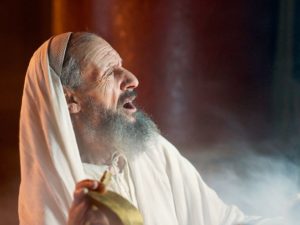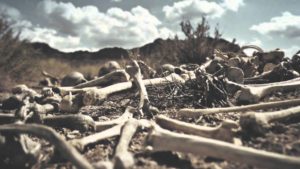Early this month I sat in on a talk about the Shroud of Turin.
I don’t know what to think about the Shroud, but whether genuine or faked it’s a stunning piece of work. The image of a crucified man is somehow burned into the cloth, which has not deteriorated near as badly as a fabric dating from the first century, or even from the 7th or 13th. It’s fine linen woven in a herringbone pattern, very expensive for the time—only a wealthy man could buy it. This costly fabric, and the costly myrrh and aloes found on it, were put to what a contemporary observer would consider a mean, lowly, thoroughly inappropriate use.
The man: his face is bruised, swollen at the cheekbones. Eyes almost squeezed shut. The nose is shoved a little out of place and the forehead clenched. One shoulder is dislocated and one knee appears to be pushed harder against the cloth because rigor mortis set in while he was still on the cross (that is, he was thoroughly dead). Those who took him down and wrapped him up would have had to force his arms and legs into place. There’s a spear wound in his side and on his back are 110-120 lash marks left by the typical Roman scourge of three tails. The body is naked, the hands crossed over his genitals for decency’s sake.
I gave my back to those who strike
. . . his appearance was so marred, beyond human semblance . . .
He was despised, and we esteemed him not
He was bruised for our transgressions
. . . and with his stripes we are healed
I don’t like sermons on the torture of Christ. I don’t like detailed descriptions of his physical suffering or brutal, humiliating treatment. I didn’t see The Passion of the Christ and probably never will. I’m squeamish about blood and gore on the big screen, but also, it’s him. It causes me to tremble.
But there on the cloth is the crucified man—is it him? It’s somebody with a very specific description: Jewish male, 5’11”, well-built and muscular, type AB+ blood. Battered and bloodied, pierced and shamed. A curse, and accursed.
Whoever it is, it represents a hideous object planted—thrown, hurled—at the center of human history. This is what it cost him. This is what I cost him.
I’ve been having a discussion with a friend about theories of atonement. She quotes Farther Richard Rohr, a Franciscan: “The terrible and un-critiqued premise is that God could need payment, and even a very violent transaction, to be able to love and accept [his own] children!”
Well. Over ways are not his ways, and so on. But Fr. Rohr’s premise is wrong. It’s not that God requires payment to love those who are already his children. God’s justice requires payment in order for God’s love to make confirmed and unrepentant rebels into children.
He takes sin very seriously; we don’t. Since the fall, it’s impossible for corrupted flesh and blood to inherit the kingdom–unless the kingdom comes as flesh and blood and gives his back to those who strike. He knows the cost; we don’t.
Yet it was the LORD’s will to crush him, and cause him to suffer,
and the LORD has laid on him the iniquity of us all.
The Lord shed the blood of an animal—probably more than one—to cover the shame of the first humans, our parents. He descended in fire at Sinai, protecting his holiness with smoke and lightning, to prescribe a temporary means of sanctification by blood: “You will be my people and I will be your God.” But not your Father—not yet. Not your Father by blood, until his own Son appears, in flesh and blood.
I don’t like the torture part, because I don’t like to think I had anything to do with it. But that mark there—that’s from my playing holy while acting carnally. That clenched brow is for my continual glory-seeking. In my youth I sinned blatantly and today I sin subtly, in a way no one sees but me. And him.
Are you washed in the blood of the lamb? How repulsive is that thought to our sophisticated minds. The ancient pagans used to drench themselves in the blood of freshly-slaughtered, still-bellowing bulls, in orgies of self-abnegation—aren’t we way, way beyond that?
Not really. God knows something we don’t: sin is serious. He is serious. His justice will see it punished, but his love will see the punishment that brought us peace fall upon Him, and heal us with those stripes.









 Few prophets–few men or women, period–lived through as much dramatic and consequential history as Jeremiah, but he’d rather have skipped it all. Most of us would–he was a living, breathing example of “shoot the messenger.” His ministry spanned King Josiah’s reformation (he wrote an elegy for the funeral) to King Zedekiah’s rebellion that ended it all for the southern kingdom.
Few prophets–few men or women, period–lived through as much dramatic and consequential history as Jeremiah, but he’d rather have skipped it all. Most of us would–he was a living, breathing example of “shoot the messenger.” His ministry spanned King Josiah’s reformation (he wrote an elegy for the funeral) to King Zedekiah’s rebellion that ended it all for the southern kingdom.
 (throughout the period of the Judges), and failed as a Kingdom, first with Saul and then with a whole line of despotic, unfaithful kings. But this is much worse than failure.
(throughout the period of the Judges), and failed as a Kingdom, first with Saul and then with a whole line of despotic, unfaithful kings. But this is much worse than failure.




 hard part. Or actually, it’s always hard, speaking truth to stony hearts, but the miracles will soon be out while oracles and exhortations are in. Israel (the northern kingdom, that is) is hanging on only by God’s mercy: Amos and Hosea are sent to warn them, first by words and then by actions.
hard part. Or actually, it’s always hard, speaking truth to stony hearts, but the miracles will soon be out while oracles and exhortations are in. Israel (the northern kingdom, that is) is hanging on only by God’s mercy: Amos and Hosea are sent to warn them, first by words and then by actions.
